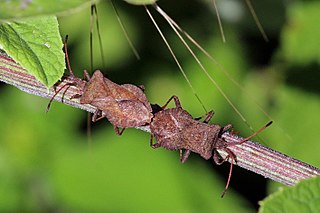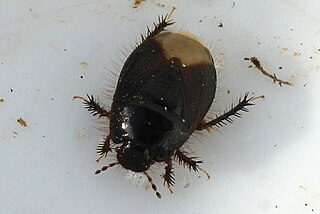
Hemiptera is an order of insects, commonly called true bugs, comprising over 80,000 species within groups such as the cicadas, aphids, planthoppers, leafhoppers, assassin bugs, bed bugs, and shield bugs. They range in size from 1 mm (0.04 in) to around 15 cm (6 in), and share a common arrangement of piercing-sucking mouthparts. The name "true bugs" is often limited to the suborder Heteroptera.

The Heteroptera are a group of about 40,000 species of insects in the order Hemiptera. They are sometimes called "true bugs", though that name more commonly refers to the Hemiptera as a whole. "Typical bugs" might be used as a more unequivocal alternative, since the heteropterans are most consistently and universally termed "bugs" among the Hemiptera. "Heteroptera" is Greek for "different wings": most species have forewings with both membranous and hardened portions ; members of the primitive sub-group Enicocephalomorpha have completely membranous wings.

The hawthorn shield bug is a common European shield bug. Its chief food is haws, the fruit of the hawthorn tree, but adults can overwinter on a diet of leaves, and individuals can be found on many potential food plants, including pedunculate oak, sessile oak and whitebeam. They may grow up to 17 mm (0.67 in) long, and are camouflaged in shades of green and brown. Like many so-called "stink bugs", they may release unpleasant odours when disturbed.

Woodlice are terrestrial isopods in the suborder Oniscidea. Their name is derived from being often found in old wood, and from louse, a parasitic insect, although woodlice are neither parasitic nor insects.

Zelus is a genus of insects in the family Reduviidae, the assassin bugs. There are currently 60 described species; most occur in Central and South America, and five are found in North America.

Coreus marginatus is a herbivorous species of true bug in the family Coreidae. It is commonly known as the dock bug as it feeds on the leaves and seeds of docks and sorrels. It is a medium-sized speckled brown insect, between 13 and 15 mm long as an adult, with a broad abdomen. It occurs throughout Europe, Asia and northern Africa. It is often found in dense vegetation, such as hedgerows and wasteland.

The Holoptilinae are a subfamily of Reduviidae known as feather-legged bugs or ant wolves. Several members of the subfamily specialize on ants. About 16 genera are known, with about 80 species described. Species in the Holoptilini tribe possess a specialized organ called a trichome to attract ants.

Megaloceroea recticornis is a species of plant bugs in the Miridae family, that is found throughout the British Isles, much of mainland Europe, and North America.

Dufouriellus is a monotypic genus of minute pirate bugs in the tribe Dufouriellini. The described species is Dufouriellus ater, which has been recorded from much of western Europe through to Bohemia, Moravia, Slovakia, southern Scandinavia and including the British Isles.

Dipsocoridae are a family of heteropteran bugs known as jumping ground bugs. There are about 30 widely distributed species which are placed in three genera. Fossils from Eocene amber have also been placed in the family.

Enoplops is a genus of Palaearctic bugs, in the family Coreidae and tribe Coreini. Species are recorded from Europe and includes E. scapha found in the British Isles; there are also records from North Africa and China.
Pseudomegacoelum beckeri is a genus of capsid bugs in the tribe Mirini; it is the type species in its new genus, having previously been placed in the genus MegacoelumFieber, 1858. This species is widespread throughout Europe, including the British Isles, where it can be found on Scots pine: Pinus sylvestris.
Psallodema is a genus of mostly European capsid bugs in the tribe Phylini, erected by V.G. Putshkov in 1970. The species Psallodema fieberi is recorded from northern Europe including the British Isles.

Hadrodemus is a genus of mostly European capsid bugs in the tribe Mirini, discovered by Franz Xaver Fieber in 1858. The type species Hadrodemus m-flavum is recorded from northern Europe including the British Isles.
Pachycoleus is a genus of bugs in the family Dipsocoridae, erected by Franz Xaver Fieber in 1860. The type species Pachycoleus waltli is recorded from northern Europe including the British Isles.
Notochilus is a genus of mostly European bugs in the tribe Drymini, erected by Franz Xaver Fieber in 1864. The species Notochilus limbatus is recorded from northern Europe including the British Isles.

Xylocoridea is a monotypic genus of exclusively European flower bugs in the tribe Dufouriellini, erected by Odo Reuter in 1876. The "xylo-" prefix indicates that these insects are associated with wood.

Brachycarenus is a genus of bugs in the family Rhopalidae and the tribe Rhopalini, erected by Franz Xaver Fieber in 1860. The species Brachycarenus tigrinus is recorded from much of Europe ; the British Isles, where it was a fairly recent (2003) introduction.

Byrsinus is a genus of burrowing bugs in the tribe Geotomini, erected by Franz Xaver Fieber in 1860. The species Byrsinus flavicornis is recorded from northern Europe including the British Isles.
















